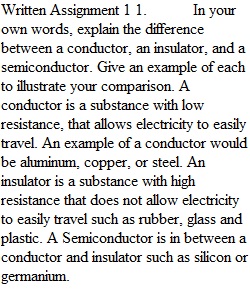


Q Answer all of the following questions. Do not send in a partially completed assignment. Answer each question as completely as possible, but do not merely copy answers from your reading materials. If you cite a reference in the text, explain the meaning of the citation. 1. In your own words, explain the difference between a conductor, an insulator, and a semiconductor. Give an example of each to illustrate your comparison. 2. Explain the difference between charging by induction and charging by contact. Include details of how the charging occurs. 3. If two equal charges are separated by a certain distance, the force of repulsion is F. Given F1, if each charge in F1 is doubled and the distance is cut in half, what is the new value of the force of repulsion, F2? Express your answer in terms of F1. 4. The electrical force on a 2-coulomb charge is 60 Newtons (N). What is the magnitude of the electric field at the place where the charge is located? 5. What is an electric field? How do you determine the magnitude and direction of the field at a given point? 6. Two point charges are separated by 6 cm. The attractive force between them is 20 N. Find the force between them when they are separated by 12 cm. (Why can you solve this problem without knowing the magnitudes of the charges?) 7. Explain the difference between electrical potential and electrical potential energy. 8. What is the voltage at the location of a 0.0001-coulomb charge that has an electric potential energy of 0.5 joules? 9. A droplet of ink in an industrial ink-jet printer carries a charge of 1.6 x 10–11 coulombs and is deflected onto paper by a force of 3.2 x 10–4 Newtons. Find the strength of the electric field to produce this force. 10. Cite the three major differences between gravitational and electrical forces. Use the Add Submission button below to submit your assignment.
View Related Questions